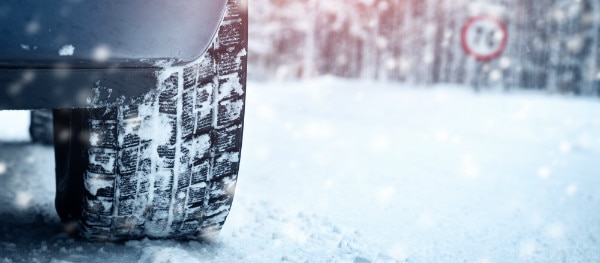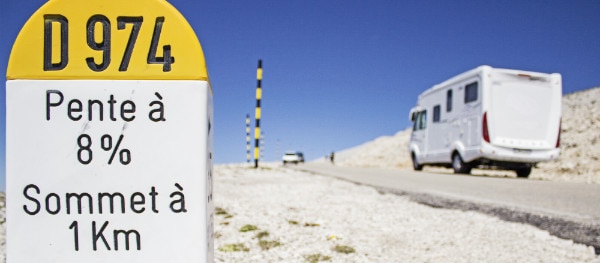Driving in the mountains: how should you do that?
8 March, 2018
Going on a wintersports holiday by car? Or setting off for Spain or the South of France in the summer? There’s a good chance you will have to negotiate some mountains on the way. And driving in the mountains is a totally different skill to driving on level ground. If you want to cross the mountains easily and safely, read our tips on driving in the mountains.
1. Good preparation is half the work
Preparing for your journey is always a good idea, but if you are driving through mountains it will certainly do no harm to check out the route extra carefully. Look carefully to see if all the roads are accessible and find out what type of road it is. Weather conditions and roadworks can lead to road closures, but some mountain passes are simply too steep or too narrow for your motorhome or caravan. Also a few mountain passes are still closed to traffic in spring and autumn.
As well as yourself, your car or motorhome must also be well prepared for the journey. The steep climbs and descents make very different demands on your car. It is an uneven battle and your vehicle must be in good condition. Check not only your oil and brake fluid but also the various brake components, the clutch, timing belt and radiator system. A service before you depart will do no harm!
2. Pay special attention to your tyres
Tyres are really included in the preparation for your journey, but as they are extremely important in the mountains, we’re giving them a special section. The safety of your journey depends on the quality of your tyres. A good grip is vital on steep, narrow mountain passes, whether or not they are covered in snow. Make sure therefore that your tyres have sufficient tread and air pressure. It you are travelling to a wintersports area or if you expect wintry conditions on your journey, check to see if snow chains are required and take a set with you. In some countries it is actually mandatory to have snow chains with you.
3. Know the traffic rules
As the last part of the preparation it’s also a good idea to familiarize yourself with traffic regulations. This will prevent unfortunate surprises and reduce the chance of difficult manoeuvres on a mountain climb. Of course the normal traffic regulations for each country are still in force in the mountains (check if these are different to your own country, such as in Spain or Germany for example), but there will also be a number of additional traffic regulations in force.
The most important rule in the mountains is that traffic going uphill always has priority over traffic going downhill. It is harder for uphill traffic to get up to speed so it has priority, but don’t take that for granted. The ‘use your common sense’ rule is probably more important than a traffic regulation. A heavily laden truck coming down the mountain won’t be able to stop so easily, so in cases such as these you might have to deviate from the normal rules.
4. Let your engine do the work
Can you still hear your driving instructor’s voice when revving up too fast, going on about economic driving in a high gear? Ignore it and forget this advice when driving in the mountains. Driving a car with low revs in the mountains is the same as cycling up a mountain in top gear. By doing this you put too much strain on the engine and you run the biggest chance of the engine overheating.
Change down a gear and let the engine rev up. 3000 revolutions is perfectly normal. Or follow the rule of thumb: if you press down on the accelerator you should be able to increase speed. If this doesn’t happen, change down a gear. Having abandoned energy efficient driving you will of course use more fuel, especially if you are towing a caravan or trailer tent. There are usually fewer petrol stations in mountainous regions, so always fill up before you drive into the mountains!
5. Practice the hill start
The hill start will also be familiar from your driving lessons. It’s quite likely you don’t have to do this every day so it will do no harm to practice it once again. Driving off with a fully laden car on a steep slope requires optimal control of the vehicle. Make sure the clutch slips as little as possible and use the hand brake.
6. Ascending and descending in the same gear
You’ve reached the top of the mountain? If you don’t suffer from heights you can enjoy the view, but don’t forget you have to drive down. Maybe the drive uphill was nerve-racking but just think about the downhill drive along narrow roads with sharp bends past deep ravines. Forget those pictures of Tour de France racers going full speed down the mountain with their chin on the handle bars, and take your time for the descent.
Use the same gears for driving downhill as you used for going uphill. By doing this you are braking with your gears and sparing your brakes (see also tip 8). The rule of thumb also applies to driving downhill: if you take your foot off the pedal the car should decrease speed. If this doesn’t happen, go down a gear.
7. Good cornering
Most mountain roads have sharp bends, commonly known as hairpin bends. Most of these bends are also steep, so brake in plenty of time and go down a gear well before the bend. Generally you can take these bends in second gear and at a maximum of 20 kilometres an hour. When driving downhill always look further down the hill so you can anticipate other traffic in time. If you are driving a motorhome with an overhang behind the back wheels, give yourself plenty of room on bends so the back of your motorhome does not scrape the road surface.
8. Spare your brakes
While driving downhill you will need to brake now and again to reduce speed. It’s better to brake short and hard a couple of times, rather than keeping the brake pedal pressed halfway all the time, By braking short and hard it gives the brakes time to cool down again. When braking gently for a long time, cooling down is not possible and there is a greater risk of overheating, and ultimately a defective braking system.
9. Look out for cyclists
You will often meet cyclists in the mountains, especially in the summer months. Every racing cyclist wants to feel like a Tour de France cyclist at some stage, and tackling the famous ‘cols’ is all part of this. Going downhill there’s a good chance that the cyclist will be going faster than the car, so keep an eye on your mirrors. Cyclists going uphill will be a lot slower but the incline and exhaustion may cause them to swerve. Overtake a cyclist giving plenty of room and always indicate when overtaking. This way it is also safe for them on the mountain and you reduce the risk of terrible accidents.
With these tips in mind, you are well prepared for your drive through the mountains. Because driving in the mountains is no everyday event for many other drivers, it remains important to pay attention and be accommodating in traffic. Take your time and do not rush your journey. That will give you time to enjoy the beautiful views on the way!












3 Comments
Hi – I often see weight limit signs and am confused about if it’s a compulsory instruction or advisory. For instance I see a red bordered white circular sign with 3.5t in it. I read this that my 3.5t unladen weight motorhome cannot ascend the pass because it is laden and has a trailer on the back.
Do have any clarity on this matter as it’s not until you are half way up you find out you cannot proceed!
Hi David,
Good question! We’ve did some research on this matter. If you see a weight limit sign then it is a compulsory instruction. If your motorhome is heavier than 3.5t and you are driving there, it might be possible that you receive a fine when then weigh your motorhome. The reason that there is a sign on these particular roads, is that the braking power of the motorhomes could be insufficient when in a emergency situation. Mostly these signs are applicable for trucks. If your motorhome is too heavy, then I want to advise you to check your routes beforehand.
Kind regards, Lucia
The 3.5t weight limit normally means the mgw [maximum gross weight]. 3.5t is standard for most motorhomes although some are bigger and you are likely to know if you fall into that category.
Unfortunately many motorhomes which are registered as 3.5t mgw are overweight as there is little extra capacity on many new vans with fuel, water and passengers included.